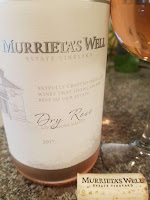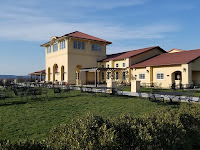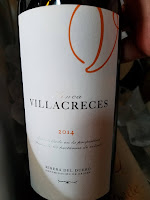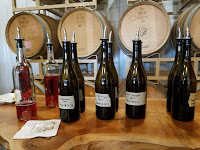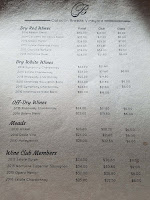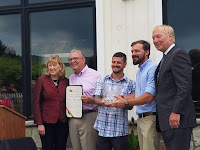 Each year the Maryland Wineries Association holds a state competition now named the Comptrollers Cup that is a blind tasting historically judged by fellow winemakers. This year other industry professionals such as sommeliers joined the panels and the Best in Show winner was a winery that I belong to their wine club: Catoctin Breeze Vineyard and their 2016 Estate Cabernet Franc.
Each year the Maryland Wineries Association holds a state competition now named the Comptrollers Cup that is a blind tasting historically judged by fellow winemakers. This year other industry professionals such as sommeliers joined the panels and the Best in Show winner was a winery that I belong to their wine club: Catoctin Breeze Vineyard and their 2016 Estate Cabernet Franc.  Catoctin Breeze is located north of Frederick Maryland on Route 15 between Thurmont and Emmitsburg. It was founded in 2010 when Voytek Leon Fizyta planted two blocks of vines along a hill slightly east of the Catoctin Mountains. These blocks consisted of Cabernet Franc, Syrah, Chardonnay, and Viognier. The well draining, loose, alluvial soil contains some quartz deposits which assist in preventing frost prevention as well as the ripening of fruit. The estate also receives a consistent breeze from Owen's Gap - keeping the vines ventilated helping to prevent mold formation - which is also limited by abundant morning sun. Today there are 7,000 vines carefully maintained by Vineyard Manager, Larry Sipe. The winery also augments their portfolio with fruit grown from a vineyard in St. Mary's Maryland - a sandy coastal region.
Catoctin Breeze is located north of Frederick Maryland on Route 15 between Thurmont and Emmitsburg. It was founded in 2010 when Voytek Leon Fizyta planted two blocks of vines along a hill slightly east of the Catoctin Mountains. These blocks consisted of Cabernet Franc, Syrah, Chardonnay, and Viognier. The well draining, loose, alluvial soil contains some quartz deposits which assist in preventing frost prevention as well as the ripening of fruit. The estate also receives a consistent breeze from Owen's Gap - keeping the vines ventilated helping to prevent mold formation - which is also limited by abundant morning sun. Today there are 7,000 vines carefully maintained by Vineyard Manager, Larry Sipe. The winery also augments their portfolio with fruit grown from a vineyard in St. Mary's Maryland - a sandy coastal region. Visitors are normally either touring wineries or taking side trips after visiting Liberty Mountain Resort, Cunningham Falls State Park, or the Catoctin Zoo and are offered three tasting packages: Signature ($10), Premier ($12), or Sweet ($8) - the later including three Mead wines. I generally prefer the Premier tasting as it usually includes wines available in the wine club. In my previous visits this has included different vintages of the Serenade Sauvignon Blanc ($24), Estate Chardonnay ($24), Estate Cabernet Franc ($36) , Concerto Bordeaux Blend ($35), and the Oratorio Barbera ($38). As you can tell, the brands have a classical music theme. The Comptrollers Cup 2016 Estate Cabernet Franc is a treat and while sampling you can view the actual cup behind the tasting bar. The wine starts with black fruit and leather on the nose which transitions into the mouth feel where hints of tobacco and dirt round in before seguing to a long and soft finish. A cup worthy wine.
Visitors are normally either touring wineries or taking side trips after visiting Liberty Mountain Resort, Cunningham Falls State Park, or the Catoctin Zoo and are offered three tasting packages: Signature ($10), Premier ($12), or Sweet ($8) - the later including three Mead wines. I generally prefer the Premier tasting as it usually includes wines available in the wine club. In my previous visits this has included different vintages of the Serenade Sauvignon Blanc ($24), Estate Chardonnay ($24), Estate Cabernet Franc ($36) , Concerto Bordeaux Blend ($35), and the Oratorio Barbera ($38). As you can tell, the brands have a classical music theme. The Comptrollers Cup 2016 Estate Cabernet Franc is a treat and while sampling you can view the actual cup behind the tasting bar. The wine starts with black fruit and leather on the nose which transitions into the mouth feel where hints of tobacco and dirt round in before seguing to a long and soft finish. A cup worthy wine.The Signature and Sweet tasting packages contain a range of Vidal, Chardonnay, a Merlot-Syrah blend in the Bolera Blend, and the three honey wines. These are all from a large 2010 vintage and each has a touch of sweetness without any clawing sugary aftertaste. The Honeymoon ($25) is blended with orange juice and feels like fall whereas the Amber ($23) is spiced with Christmas flavors. Both are solid meads. However, we came home with a bottle of the Dolce Vita ($24), a melomel mead made with blackberries. The berry flavors are prevalent with the sweet honey kicking in near the tail. Nicely done.
 After sampling the wines kick back on their large back lawn to view the vines and let the kids and dogs play. The winery hosts food trucks on weekends as it has no other food options and the food trucks are usually paired with a musical act. In conclusion, I make Catoctin Breeze Vineyard a regular visit; you should as well. And as always theCompass Craft Beverage Finder will help in that regard.
After sampling the wines kick back on their large back lawn to view the vines and let the kids and dogs play. The winery hosts food trucks on weekends as it has no other food options and the food trucks are usually paired with a musical act. In conclusion, I make Catoctin Breeze Vineyard a regular visit; you should as well. And as always theCompass Craft Beverage Finder will help in that regard.Catoctin Breeze Vineyard
15010 Roddy Road
Thurmont, MD 21788
240-578-3831
Monday-Thursday: 11:30am-3:00pm
Friday: 11:30am-9:00pm
Saturday: 12:00-6:00pm
Sunday: 12:00-5:00pm


